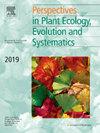杂交方向影响两个二倍体榕树类群同倍体杂交的种子选育和后代适合度
IF 2.9
3区 环境科学与生态学
Q1 ECOLOGY
Perspectives in Plant Ecology Evolution and Systematics
Pub Date : 2025-10-06
DOI:10.1016/j.ppees.2025.125901
引用次数: 0
摘要
了解生殖隔离机制对于描述新物种的起源至关重要。在开花植物中,这些机制显著影响杂交率(自然群体中杂种形成的频率)和杂交成功率(对照杂交中的结实率和发芽率),并且通常与杂交适应度的不对称有关。Ficaria为研究杂交和生殖分离提供了一个有价值的系统,因为主要是四倍体,广泛的系统地理分类群(谱系)verna (V)被认为是由两个近二倍体分类群(谱系)calthifolia (C)和fertilia (F)之间的杂交产生的,然后是多倍体化。为了评估生殖隔离的程度和方向性,我们在上述二倍体之间进行了控制的谱系内和成对互惠杂交,评估了生殖保证(自主无融合、自交),并分析了获得的F1后代的基因组大小、形态和适合度。在亲本二倍体系或杂交种中未发现自主无融合或自交受精的证据。互易系间杂交(F-C杂交:n = 76;C-F杂交:n = 45)产生可活的二倍体F1后代,其基因组大小介于亲本系之间。以上说明,正交的F1后代均来自异花授粉。杂交处理后的后代未见多倍体个体。系间杂交的后代比系内杂交的后代表现出更大的形态变异。然而,系间杂交是不对称的。当C为种亲本时,与F为种亲本时相比,杂交产生的种子数量较少,发芽率较低,已建立的杂交种的育性降低。然而,这些杂交种比它们的同类表现出更高的身材和更大的花朵。这些不对称可能反映了亲本世系之间的受精卵后细胞核不相容。我们的研究强调了杂交和不对称生殖障碍在塑造榕树进化中的重要性,并为进一步研究导致多倍体化的基因组复杂性奠定了基础。本文章由计算机程序翻译,如有差异,请以英文原文为准。
Direction of the cross affects seed siring and progeny fitness in experimental homoploid crosses between two diploid Ficaria taxa
Understanding reproductive isolation mechanisms is essential for describing the origin of new species. In flowering plants, these mechanisms significantly affect hybridization rates (frequency of hybrid formation in natural populations) and crossing success (seed set and germinability in controlled crosses) and often are associated with asymmetries in hybrid fitness. Ficaria offers a valuable system for studying hybridization and reproductive isolation, as predominantly tetraploid, widespread phylogeographic taxon (lineage) verna (V) is thought to have arisen by hybridization between two parapatric diploid taxa (lineages) calthifolia (C) and fertilis (F) followed by polyploidization. To assess the extent and directionality of reproductive isolation, we conducted controlled intra-lineage and pairwise reciprocal crosses between the aforementioned diploids, evaluated reproductive assurance (autonomous apomixis, selfing) and analysed genome size, morphology and fitness of obtained F1 progeny. No evidence of autonomous apomixis or self-fertilisation was found in the parental diploid lineages or the hybrids. The reciprocal inter-lineage crosses (F–C cross: n = 76; C–F cross: n = 45) produced viable diploid F1 progeny whose genome size was intermediate between that of the parental lineages. The above implies that all F1 progeny in reciprocal crosses originated from cross-pollination. No polyploid individuals were observed among the progeny resulting from any cross treatment. Progeny from inter-lineage crosses exhibited greater morphological variation than progeny from intra-lineage crosses. However, inter-lineage hybridisation was asymmetric. When C was the seed parent, the crosses yielded a lower number of seeds with lower germination rates and reduced fertility of established hybrids, in comparison to when F was the seed parent. Yet these hybrids exhibited greater stature and larger flowers than their reciprocals. These asymmetries likely reflect postzygotic cytonuclear incompatibilities between parental lineages. Our research highlights the importance of hybridisation and asymmetric reproductive barriers in shaping the evolution of Ficaria and establishes a basis for further studies on the genomic complexities that lead to polyploidisation.
求助全文
通过发布文献求助,成功后即可免费获取论文全文。
去求助
来源期刊
CiteScore
6.50
自引率
0.00%
发文量
28
审稿时长
67 days
期刊介绍:
Perspectives in Plant Ecology, Evolution and Systematics (PPEES) publishes outstanding and thought-provoking articles of general interest to an international readership in the fields of plant ecology, evolution and systematics. Of particular interest are longer, in-depth articles that provide a broad understanding of key topics in the field. There are six issues per year.
The following types of article will be considered:
Full length reviews
Essay reviews
Longer research articles
Meta-analyses
Foundational methodological or empirical papers from large consortia or long-term ecological research sites (LTER).

 求助内容:
求助内容: 应助结果提醒方式:
应助结果提醒方式:


